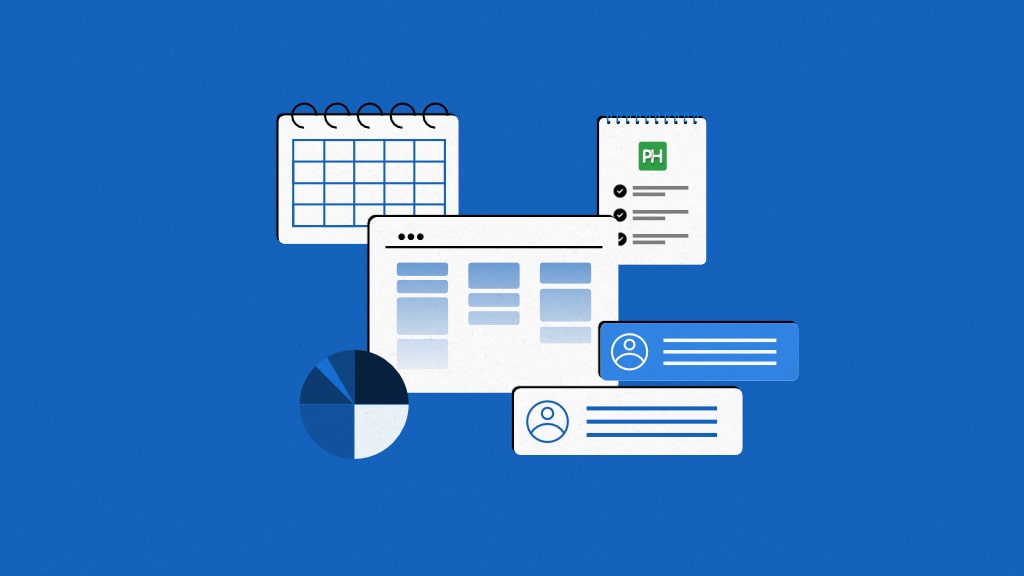Introduction
By now, you have probably understood the value of project management in completing a project on time and within budget and realized that you need project management software to implement the knowledge, practices, and techniques of project management to your projects.
Now, the challenge you face is choosing the right type of project management software for your organization because hundreds of software are available in the market. In addition, you probably do not have prior knowledge or experience using project management software. This makes choosing the right software for your business overwhelming.
Purposefully, in this post, I have covered the various types of project management software based on different parameters, such as project management function, industry, business size, methodology, and deployment type—so that you can understand and shortlist the right option.
It is a crucial decision that can impact your company’s finances, the successful implementation of project management, and the team’s easy adoption of the software.
What is project management software?
Project management software is a digital collaboration tool that brings projects, teamwork, and team communication in one place to make it easy to work together. You get a comprehensive set of features to plan projects, implement project management methodologies, and facilitate collaboration among the team and stakeholders of the project.
The purpose of using a project management system is to provide you with a platform to apply project management to a project efficiently. You can implement project management with pen and paper or spreadsheets. Still, it is not a suitable option in the modern-day competitive world where managers are consistently under the pressure of productivity and delivering projects on time.
Key features of project management software
Project management software can have endless features. However, software needs some features to qualify as project management software. Have a look at the core features of project management software.
- Project planning: It allows you to break a project into tasks, define an order in which tasks need to be completed, set dependencies of tasks, allocate resources for each task, estimate the budget and time for each task, and add milestones.
- Task management: It allows you to create tasks, add information related to functions such as start and due dates, description, and priority, delegate to the team members, track progress, and manage changes in schedule and resources from one centralized place.
- Team collaboration: It allows team members to share files, add comments, and facilitate conversations to work together effectively and efficiently.
- Reporting: It helps you overview the project progress status and evaluate team and project performance with detailed insights from project data.
- Integrations: It allows you to integrate third-party apps, such as cloud storage, communication tools, and calendars, with your project management software to expand its capabilities and streamline workflows.
Different types of project management software and examples
There are hundreds of project management software in the market with varying areas of focus, unique strengths, and targeting different audiences. Therefore, it is essential to understand the types of project management tools to choose the right software for your business needs.
Different categorizations of the project management software are based on the project management function, industry, business size, methodology, and deployment type.
Look at each project management software type in detail with examples of the best tools in that category.
1. By project management function
The most reliable way to categorize project management software is based on the project management function. Regardless of the industry, business size, or any other factor, a project goes through all these functions.
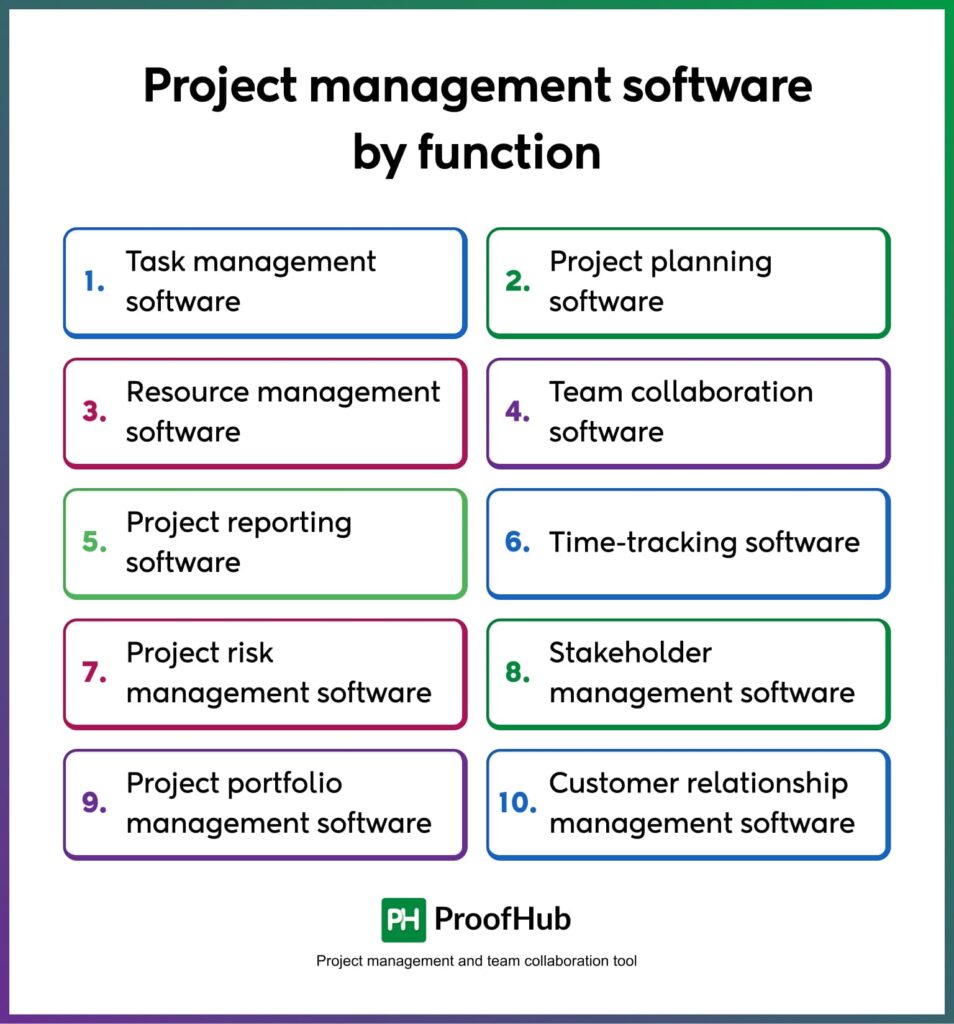
Top project management functions include project planning, task management, resource management, team collaboration, document management, project reporting, time tracking, risk management, and client management.
Based on these job functions, you will find different types of project management systems with one primary area of focus on the respective job functions and providing all the essential features for project management software.
Have a look at the 10 main project management software types:
1. Task management software
Task management software is the most widely used by businesses seeking to enhance operational efficiency and team collaboration. It focuses on simplifying creation, delegation, and managing tasks, breaking a project into tasks, setting goals, tracking progress, and collaborating with team members.
This type of tool helps businesses streamline operations, ensure accountability, facilitate collaboration, and improve productivity.
Key features of task management software include:
- Creating and delegating tasks: You can create tasks, assign tasks to team members, and communicate changes from one centralized platform without relying on email and spreadsheets.
- Add task information: Capture all the details needed for task completion, including descriptions, start and due dates, priority labels, urgency labels, estimated time, and budget. This ensures that everyone has a clear understanding of what is required.
- Task attachments: Allows you to share the files and documents directly within the task interface. This ensures keeping all necessary information organized and easily accessible, eliminating the time spent searching for files.
- Task comments: Use @mentions to collaborate with team members on important task-related discussions. This streamlines communication and ensures that everyone remains on the same page.
- Discussion board: Facilitate broader conversions at a project level using discussion boards. This makes sharing ideas convenient, receiving stakeholders’ input, and keeping everyone aligned with project goals.
- Real-time chat: Facilitates instant one-to-one and group messaging features. This allows for quick updates and resolves issues promptly without interrupting the workflow.
- Roles and permission: Manage access and control about who can view and edit tasks by setting up various role-based permissions. This helps maintain security and ensures that only authorized personnel can make changes.
While task management software excels in organizing tasks and enhancing team collaboration, it does not typically offer advanced features such as capacity planning, budget planning, and resource management tools.
Examples of top task management software include ProofHub, Trello, and Asana.
ProofHub is one of the best project management software in the category. It provides advanced task management capabilities to manage task creation, delegation, and tracking. You also get project planning and team collaboration capabilities to make it a complete tool for the team to improve productivity.
2. Project planning software
Project planning software focuses on empowering you with unique features to help you create a detailed project plan. It enables you to manage three significant parts of a project plan: scope, budget, and timeline.
Ideal for managers who need a structured approach to project planning, as this software simplifies the project creation and makes their management detailed or elaborative.
Key features of project planning software include:
- Project hierarchy: Break down a project into phases, tasks, and sub-tasks with a hierarchical structure. This helps define the project scope and ensures every detail is accounted for.
- Task management: Set start and due dates, allocate resources, and set estimated time and budget for each task. This makes managing and tracking project progress and creating a project plan easier.
- Gantt Chart: Visualize the project plan on a timeline with Gantt charts. These charts also help manage task dependencies, set milestones, oversee resources, and plan for risks.
- Calendar: View and manage resource schedules and availability using integrated calendars. This helps in capacity planning, managing time effectively, and avoiding scheduling conflicts.
Examples: Zoho Projects, Smartsheets, and Project Manager.
Check out: 11 Best project planning tools for project management in 2025
3. Resource management software
You need resource management software for companies with shared resources across multiple projects, and your clients need high-level transparency in resource utilization and billable hours. These tools help you schedule resources for a project, visualize the percentage allocation of a resource across projects, and efficiently distribute the workload evenly among your resources.
Key features of resource management software include:
- Percentage resource allocation: Visualize the percentage allocation of a resource across projects to understand the workload and availability of each resource.
- Resource scheduling: Utilize tools like Calendar, Gantt chart, and Kanban to schedule resources effectively. These tools help you assign tasks based on availability.
- Capacity planning: Forecast resource needs and match the demand with current availability. This benefits organizations in balancing demand and supply and helps them plan for both short-term and long-term resource requirements.
- Workload balancing: Optimize productivity by balancing workloads across your team. This feature prevents burdening individual resources and ensures a more efficient distribution of tasks.
- Utilization tracking: Track budget and time utilization to keep projects on schedule and budget. This ensures how well resources are being utilized and makes adjustments as needed.
Examples: Wrike, Kantata, and Paymo.
Check out: Best resource scheduling software for project managers
4. Team collaboration software
Team collaboration software helps you manage the collaboration aspect of a project. It provides a unified platform for communication, document sharing, real-time collaboration, and feedback on digital assets.
This type of software is available as standalone team communication apps used in integration with project management software or as a project management software with built-in collaboration features.
Key features of team collaboration software include:
- Real-time messaging: Instant communication with team members in real-time with one-to-one or group chat. This facilitates exchanging ideas quickly, sharing updates, and resolving issues as they arise.
- File sharing: Centralized file sharing by allowing team members to access local and cloud storage files. This ensures all relevant documents are organized and easily accessible.
- Collaborative documents: Co-edit on the same document and sync changes in real-time. This ensures all team members are working with the updated document.
- File versioning: Track changes and revisions made by all users on a collaborative document, highlighting changes made by users to maintain clarity and control over document evolution.
- Video conferencing: Conduct meetings using audio and video calls, facilitating face-to-face interactions and discussions. This promotes brainstorming sessions and virtual meetings regardless of team members’ location.
- Online proofing: Share feedback on digital assets using annotation, markup tools, comments, and screen recording. This feature streamlines the review process.
Examples: Basecamp, ProofHub, Slack, Google Docs, Notion, ClickUp, and Zoom.
5. Project reporting software
Project reporting software helps you visualize and analyze project data to create insights. Managers use it to evaluate project and team performance, overview the progress of a project, and share project insights with stakeholders.
Key features of project reporting software include:
- Reporting: Generate project reports by task status, assignee, time utilization, budget utilization, resource utilization, workload, and more to gain insights into project progress. These insights help track current project progress and identify areas for improvement.
- Create dashboards: Create a customized dashboard with widgets such as bars, graphs, and charts. Set KPIs and milestones to compare the progress against set benchmarks.
- Export and share: Easily export and share reports with stakeholders for project status updates and make data-driven project decisions.
Top project reporting software examples include Microsoft Power BI, Wrike, and Smartsheet.
6. Time-tracking software
Time tracking software helps you track the time spent on tasks and log it on the timesheets. It allows you to set the manual or automatic timer to track time, automatically create timesheets to save time entries, and generate client invoices based on the logged time.
This software type is used by organizations primarily for two functions:
- to improve time management, estimate project time accurately, and enhance productivity
- to report time spent on tasks for invoicing.
Key features of time-tracking software include:
- Manual or automatic timer: Track the time spent on tasks and projects using either a manual entry or an automatic timer. Start, pause, or resume tracking with a few clicks, or manually log time spent on tasks.
- Customizable timesheets: Timesheets save time tracking tasks and other details such as estimated time, actual time, billable hours, and non-billable hours on timesheets.
- Invoicing: Add hourly employee rates and pull data from timesheets to automatically calculate and generate invoices.
- Reporting: Gain insights with time reports and analyze team performance, estimate project time accurately, track resource utilization, and monitor budget to improve productivity and planning.
Examples of top time-tracking software include Clockify, TimeCamp, and Toggle Track.
7. Project risk management software
Project risk management software helps you identify, assess, and create mitigation plans for project risks. It provides dedicated risk management tools like a risk register, risk assessment matrix, and risk management templates for mitigating risks.
This tool type is ideal for businesses working on projects with higher internal and external dependencies.
Key features of project risk management software include:
- Risk register: Log all the project risks for effective risk tracking and management throughout the project.
- Risk assessment matrix: Analyze the impact of risk (Low, Moderate, Severe) and the likelihood of the happening of a risk (Unlikely, Likely, and Highly likely).
- Risk management: Convert risk into a task, assign owners, set deadlines, and prioritize actions. Track progress and collaborate with the risk owner to manage risk effectively.
- Risk prediction and alerts: Highlight projects or tasks at risk of overrunning budget or schedule. Receive alerts to the people responsible for managing risks.
Examples: nTask, Wrike, and Resolver
Read more: Best project risk management software in 2025
8. Stakeholder management software
Suppose your business involves consistent involvement of external stakeholders such as clients on a project. You would need stakeholder management software to identify, analyze, and manage the communication of stakeholders of a project. This type of software provides stakeholders with restricted access to the organization’s internal work management platform to actively participate in the project and key decisions.
Key features of stakeholder management software include:
- Stakeholder analysis and mapping: Identify and log all project stakeholders in one place and map their influence, interest, and impact on a project.
- Task management: Assign individuals to keep track of who’s engaging with stakeholders across multiple projects and are responsible for resolving their issues and managing expectations.
- Client portal: Provide external stakeholders to view project information and share feedback.
- Permission and roles: Restrict the access of a client only to the authorized projects and discussions and set roles so that you can define the access level, such as view, edit, and suggest.
Examples of top stakeholder management software include Simply Stakeholders, Project Manager, and Smartsheet.
9. Project portfolio management (PPM) software
If you are a business managing hundreds of projects, then you need project portfolio management (PPM) software. It helps you bring all the projects in one place under multiple programs and portfolios to make it easy to organize and manage them.
This type of software helps you balance resources, budgets, time, scope, and quality to ensure your projects in a portfolio meet the organizational objectives.
Key features of project portfolio management software include:
- Centralized portfolio view: Bring all the projects in a portfolio in one place to get a high-level overview of projects.
- Portfolio dashboard: Collects and represents the real-time data of all the projects in a portfolio to help you track the progress of a project, portfolio health, and performance metrics. Based on the data, you can make project-related decisions such as prioritizing projects, resource management, risk management, and change management.
- Project intake management: Manage approval requests for new projects based on the organisation’s predefined criteria and strategic goals.
- Resource management: Track the workload across the projects and allocate resources based on availability.
- Project risk management: Prioritize projects based on strategic alignment, potential value, and risks.
Examples: Microsoft Project, Smartsheet, and Celoxis.
Read more: 11 Best project portfolio management software
10. Customer relationship management software
Customer relationship management (CRM) software is not a project management software. Still, it helps you run projects successfully by keeping a record of all the interactions of customers/clients with a company. It helps companies better understand their client’s needs and deliver desired products or services.
This type of software can also be used for sales management, marketing operations, and customer service interactions.
Key features of customer relationship management software include:
- Contact management: Record all the client information, such as name, contact details, & notes from interactions in one place.
- Communication history: Access communication history from one central location to understand customer needs and journey.
- Customer outreach: Enhance your outreach efforts with tools for engaging clients and managing communications.
- Reporting: Generate reports to understand customer behavior, trends, and data to improve overall customer management strategies.
Examples of top customer relationship management software include Salesforce CRM, ZOHO CRM, and HubSpot CRM.
2. By methodology
While learning about project management, you might have figured out the suitable project management methodology for your industry and projects.
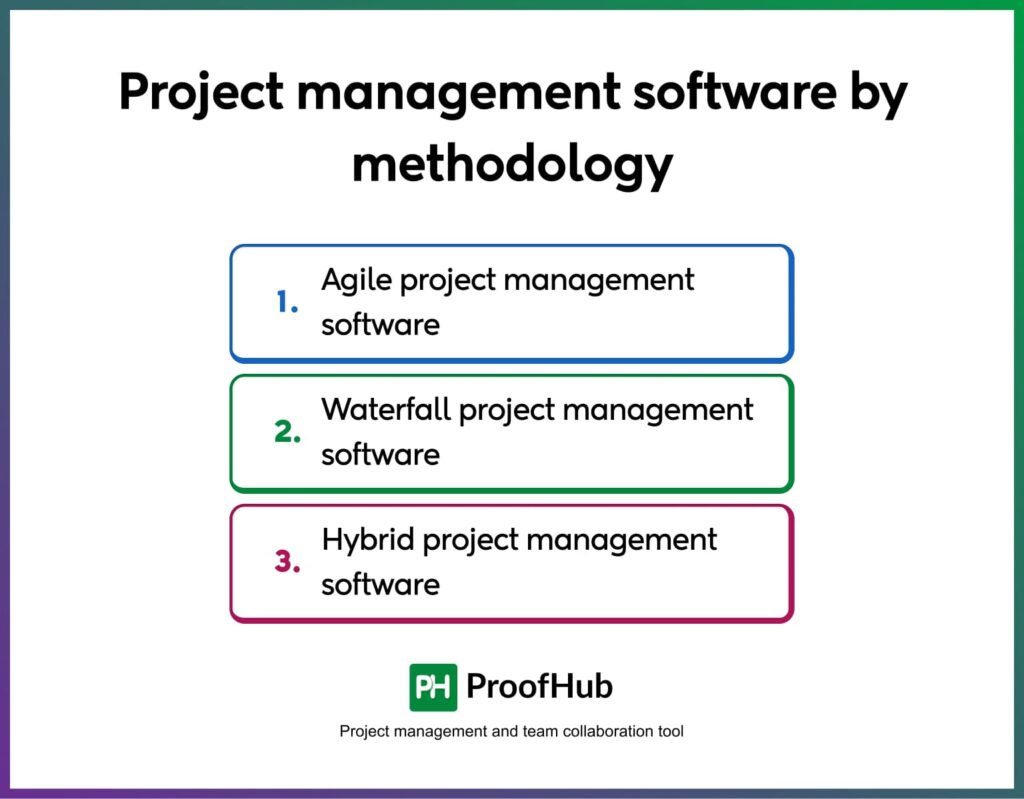
Each project management methodology offers you specific techniques. Based on the project management methodology, there are three types of project management software:
11. Agile project management software
Agile project management software provides direct features such as product backlog, sprint planning, Kanban board with WIP limits, sprint burndown chart, and CFD diagram to help you apply Agile project management methodologies like Scrum and Kanban to your projects.
This type of software is usually designed to manage software projects because the Agile project management methodology is used primarily for software development. However, you can also use it for projects from other industries if you manage them using Agile project management.
Key features of Agile project management software include:
- Backlog management: Document all the user stories of a software development project and prioritize them based on the project requirements.
- Sprint planning: Create a sprint, pick stories from the backlog, estimate sprint points, and set sprint goals.
- Agile board: Visualize the workflow and work items to be completed in an iteration. Based on the methodology used, the artefacts of an Agile board change. For example, for Kanban methodology, you have WIP limits; for Scrum methodology, you have story points and days count.
- Reports: Provide tools like burn-down charts, cumulative flow diagrams, and velocity graphs to analyze team and work progress.
- Issue and bug tracking system: Document, prioritize, and resolve issues that arise during development.
Examples: Jira, monday.dev, and Microsoft projects.
12. Waterfall project management software
Waterfall or traditional project management software helps you plan a project traditionally. It provides features to collect and document project requirements, define project scope, create a project plan, and allocate, track, and manage budget and resources for a project.
This type of software is ideal for projects with a fixed scope, well-defined deliverables, and rigid budgets and schedules, such as construction projects.
Key features of waterfall project management software include:
- Gantt chart: Create a project plan, schedule, set task dependencies, add milestones, and allocate resources for each task of a project.
- Task management: Break a project into tasks, set start and due dates, assign team members, and add the information required to complete a task.
- Document management: Create and bring all the project documents, such as client requirements, project plan, risk management plan, and project documentation, in one place.
- Project reports: Track the progress of the project and utilization tracking of a project’s budget, resources, and time.
Examples: Project Manager, GanttPro, and ProofHub.
13. Hybrid project management software
Hybrid project management software provides features to help you implement both Agile and Waterfall project management methodologies to your projects. This type of software is used for projects that use hybrid project management, i.e., Waterfall methodology for planning a project and Agile methodology for executing a project, such as marketing projects.
Key features of a hybrid project management software include:
- Project planning: Document project requirements, define project scope, gain approvals, and create a project plan. You get project planning tools like Gantt chart and PERT to create a detailed project plan.
- Kanban board: Create a workflow for a sprint, pick stories from the backlog to be included in a sprint, and add WIP limits to manage the work in an iteration.
- Resource management: IVisualize a resource allocation percentage across projects to help you with resource allocation and workload management.
- Risk management: Provides you tools like a risk register, matrix, and risk mitigation plans to help you manage project risks.
Examples: ClickUp, Airtable, and monday.com
Read more: Traditional vs Agile project management method: Which one is right for your project?
3. By industry
Every industry has its own set of feature requirements to manage projects effectively. Project management software is designed to fulfill those requirements.
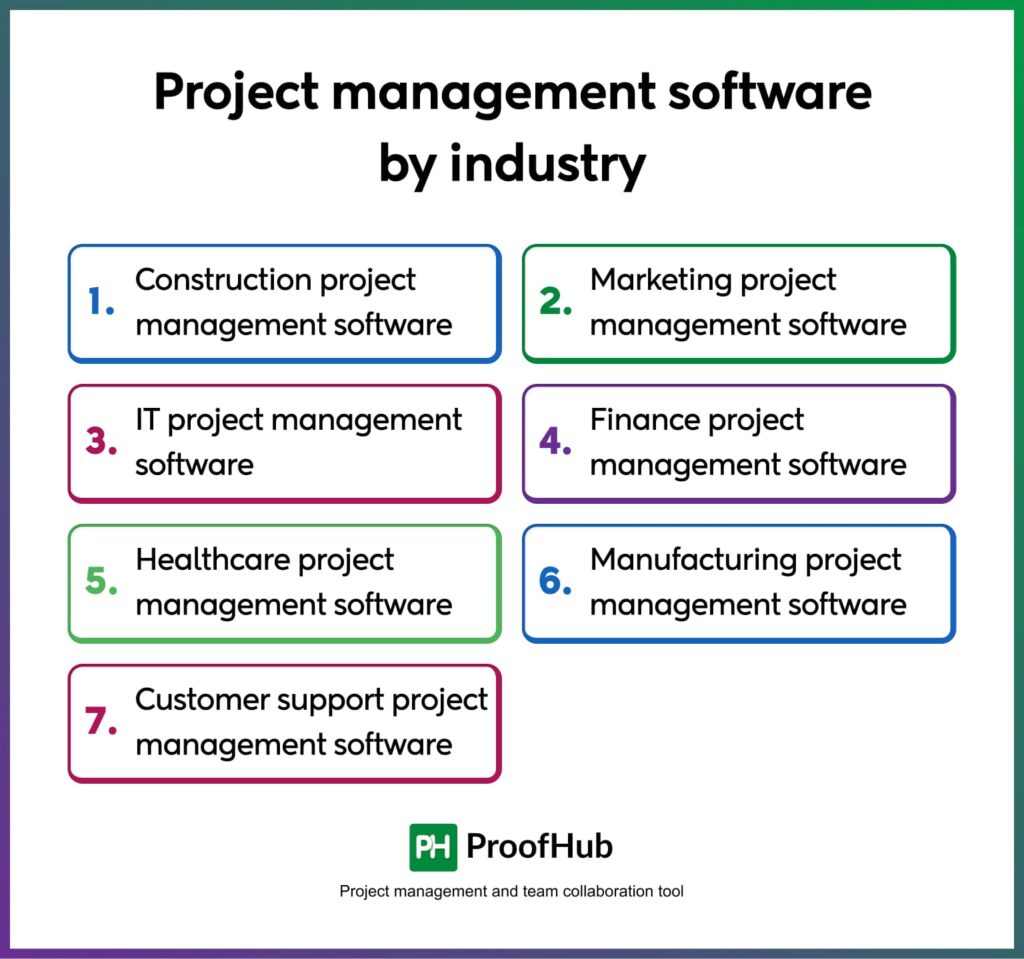
Look at the most common types of project management software in the industry.
14. Construction project management software
This type of project management software helps you create a detailed plan for construction projects, manage inventory, track the daily progress of construction projects, generate invoices, track budgets, and manage payroll.
Key features of construction management software include:
- Project planning: Create a project plan and define the order of construction activities in a project.
- Budget planning: Estimate project costs, including labour, material, and equipment.
- Inventory management: Keep track of the materials and equipment.
- Daily reporting: Track the progress of the project.
- Accounting, invoicing, and payroll management: Create invoices, pay employees, and keep financial records.
Examples: Procore, Autodesk Construction Cloud, and Fieldwire.
15. Marketing project management software
A marketing project management software focuses on improving the marketing team’s productivity and streamlining marketing operations by bringing projects, teamwork, and team communication into one place.
This type of software thrives on ease of use. It brings various tools used in managing marketing operations, such as customer relationship management (CRM) software, content management systems (CMS), social and web analytics tools, and invoicing software in one place for end-to-end work management.
Key features of marketing project management software include:
- Task management: Create, delegate, monitor, and manage tasks centrally.
- Progress tracking: Track the progress of the tasks and adjust resources, budget, and timeline for successful completion.
- Team collaboration: Facilitates team communication and document sharing to work effectively and efficiently.
- Online proofing: Edit, review, and share feedback on digital assets.
- Integrations: Connect with third-party apps such as Sprout Social, HubSpot, and Gmail for streamlined operations.
Examples: ProofHub, Trello, and Adobe Workfront.
16. IT project management software
IT project management software is designed to help you manage software development projects. These tools offer important features to create and manage backlog, document and prioritize user stories, create sprints, track project progress, and manage bugs and issues during development.
A key aspect of IT PM software is that it integrates seamlessly with other third-party tools for coding, testing, and deployment.
Key features of IT project management software:
- Product backlog planning: Create a product backlog and document and prioritize user stories.
- Sprint planning: Organize sprints and allocate resources to the tasks.
- Issue tracking: Document bugs and convert them into tasks for faster resolution.
- Internal wiki: Create an internal wiki of documents for the project team.
- Integrations: Integrate third-party apps software development apps such as GitHub, Visual Studio Code, and Jenkins.
Examples: Jira, Airtable, and GitLab.
17. Finance project management software
Finance project management software is designed to help accounting firms manage their day-to-day operations. It provides tools to manage, store, and organize many documents, a centralized place to store all the information of clients, integration with invoicing software, and a payment gateway to generate invoices and receive payments.
Key features of finance project management software:
- Database management: Record, analyze, and share data financial data.
- Invoicing and billing software: Generate invoices, send payment reminders, and process payments.
- Integrations: Connect with third-party accounting and payment apps
Examples: ProProfs Project, Jetpack Workflow, and Karbon.
18. Healthcare project management software
Healthcare project management software or systems focus on recording and organizing data with HIPAA compliance, ensuring regulatory compliance, managing electronic medical records (EMR), appointment scheduling, and reporting.
Key features of healthcare project management software include:
- Electronic medical records: Maintain a digital record of a patient history
- Appointment scheduling: Manage and organize patient appointments
- Compliance management: Ensure adherence to health care regulations and standards.
Examples: MocDoc, Scoro, and Smartsheets.
19. Manufacturing project management software
Manufacturing project management software helps you manage the production of items to ensure timely delivery. It provides features to document order requests, set dependencies, track the production cycle, and manage schedules. It integrates with supply chain management, inventory management, compliance management, and accounting invoicing software for complete business operation management.
Key features of manufacturing project management software
- Order management: Log all your orders and related information in one place.
- Cycle management: Track your fulfillment cycle from start to finish to deliver customer updates.
- Risk management: Address scheduling changes, resource shortages, and customer requests.
- Project reporting: Analyze costs, time, and resources to identify areas of improvement and analyze your margins.
Examples: Project Manager, WorkOtter, Netsuite OpenAir, and ProofHub.
20. Customer support project management software
Customer support project management software or a helpdesk ticketing system helps you document, track, and manage every interaction with clients and provide quick resolution to customers’ issues.
Key features of customer service project management software include:
- Issue management: Document issues, client information like name, contact details, & notes from interactions, and access communication history from one central location.
- Workflow automation: Automatically generate tickets and route requests to the customer service representatives.
- SLA management: Visualize SLA to ensure customers receive timely responses and resolutions.
- CSAT: Track and manage customer satisfaction with feedback forms
Examples: Zendesk, Freshdesk, and Zoho Desk.
4. By business size
Project management software should fit a business’s needs and goals. There are differences in project management software’s focus areas and strengths for small businesses, freelancers, and enterprises.
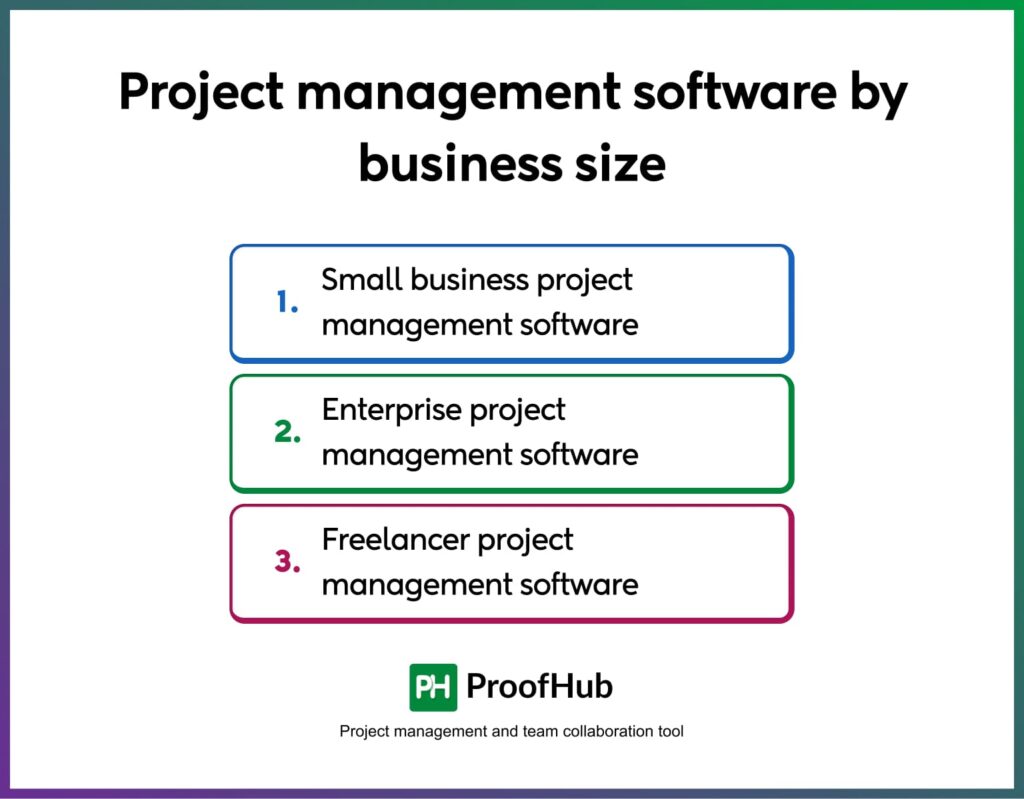
Based on the business size, project management software is divided primarily into three types:
21. Small business project management software
A small business project management software is easy to use, scales cost-effectively, and provides plenty of features under one platform. Small businesses need a solution that offers them high value for money.
Key highlights of small business software:
- Multiple features: Loaded with comprehensive features to manage projects, teamwork, and team communication under one platform. Key features include project planning, task management, project tracking, team chat, file sharing, time tracking, project progress, and online proofing.
- Easy to use: User-friendly and simple interface and is easy to learn and navigate. This reduces the onboarding and training requirements for the team, saving time and cost.
- Scale cost-effectively: Offer plans that allow you to add a growing number of users rapidly.
Examples: ProofHub, Trello, and MeisterTask.
22. Enterprise project management software
Enterprise project management software is designed with the needs of an enterprise in mind. This type of tool is secure and reliable and integrates with many third-party apps to help manage operations end-to-end.
Key highlights of enterprise project management software:
- Advanced features: Advanced project management features such as Gantt charts, budget forecasting, workload management, dashboards, invoicing, workflow automation, and third-party integrations.
- Secure and reliable: Uptime of 99.99% of the SLA and comes with advanced security measures like two-factor authentication, SSO, and encryption for enhanced security.
- Fast data processing: Hosts many users, stores massive volumes of data, and processes data quickly for a smooth user experience.
Examples: Wrike, Smartsheet, and Airtable.
23. Freelancer project management software
A freelancer project management software is a lightweight project management software that provides all the features at a basic level to help manage an individual’s work, ideally for free or at a cheap price. It does not focus on providing advanced project planning, team collaboration, and client management capabilities.
Key highlights of freelancer project management software:
- Basic work management capabilities: Provide basic work management capabilities such as project planning, to-do lists, task scheduling, task tracking, file organization, and guest access to external users.
- Easy to set up and use with self-help resources: Easy to set up and use and provide self-help resources to help an individual navigate a tool.
- Free or cheap pricing plan: Ideally, freelancers look for a free version of project management software, but most companies do not offer key features in a free plan. Thus, it should provide a cheap-paid plan to deliver high value for money.
Examples: Basecamp and Paymo.
5. By deployment and device type
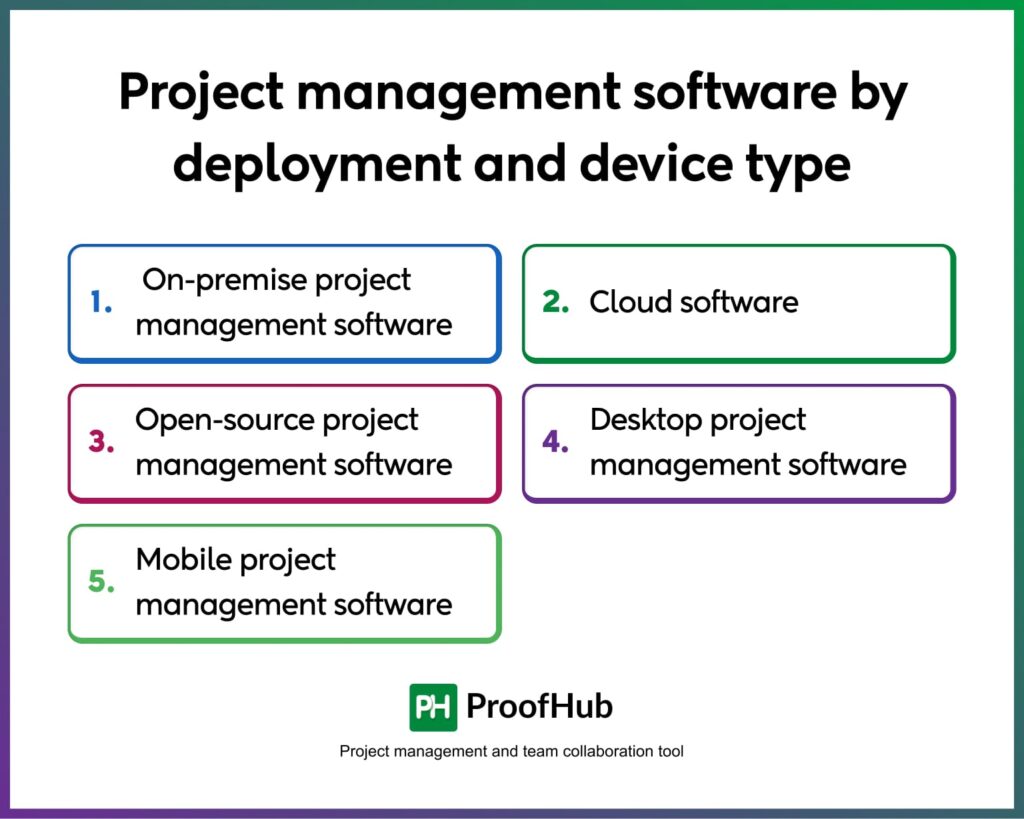
Project management software is of five types based on the deployment and device type:
24. On-premise project management software
On-premise software is installed on-site, and data is hosted on an organization’s private and local servers. This provides a high level of data security and can be customized as per your organization’s needs. But at the same time, it also requires a high level of maintenance to keep it functioning correctly, additional costs on setup and server management, and does not scale quickly.
Examples: Microsoft Project, Open Project, and ActiveCollab.
25. Cloud software
Cloud software is available as SaaS software that can be accessed over the internet. Most of the project management software in the market is cloud-based software. This type of software is easy to set up, does not require upfront investment, is easy to scale, and works on the subscription model (usually charges per user fee).
The only downside is that its data is not hosted on your private server, and you do not have control over outages. However, most SaaS tools in the market adhere to the industry security standards and compliance requirements for data protection.
Examples: Teamwork.com, Hive, and Nifty.
26. Open-source project management software
Open-source project management software is free software that provides access to its source code so anyone can inspect, modify, and enhance it. It is ideal for small businesses with in-house development capabilities that need basic project management features.
The downside of this type of software is it does not come with dedicated customer support. You need to resolve issues on your own or with support from the community.
Examples: OpenProject, Redmine, and Plane.
27. Desktop project management software
Desktop project management software is a desktop app that runs locally on a standalone computer. It can support various operating systems, such as Linux, Windows, and Mac. This type of software is usually available as open-source project management software and is free to use. Collaboration is complex in this type of software.
Examples: Freedcamp, Redmine, and LibreOffice.
28. Mobile project management software
Mobile project management software is a smartphone app that supports various operating systems, such as Android and iOS. The purpose of this type of software is to make it possible to work on the go. Most cloud-based project management software in the market have mobile apps requiring an internet connection.
Examples: Teamwork, Jira, ProofHub, Slack, and Nifty.
List of top 11 project management software for businesses
- ProofHub – Best for task management
- Trello – Best for Kanban boards
- Jira – Best for Agile project management
- Asana – Best for goal management
- Wrike – Best for workflow management
- ClickUp – Best for team collaboration
- Smartsheet – Best for enterprise-grade project management
- monday.com – Best for workflow automation
- Zoho Projects – Best for end-to-end work management
- Notion – Best for content collaboration
How to choose the right project management software for your business?
Choosing the right project management software is vital to achieve project success. Here are the few things you need to keep in mind to select the best project management software for your organization:
- Identify requirements: There are hundreds of project management software. Identify what problems you want to solve with project management software. Based on that, create a list of features and capabilities you need in project management software.
- Features: Good project management software provides a range of core features such as project planning, task management, team collaboration, progress tracking, file sharing, resource management, project reporting, time tracking, and integrations. Ensure it has all of these core and specific features you need.
- Ease to use with a friendly user interface: Project management software should be easy to use and set up so you do not have to invest months in training. It should have a user-friendly interface and a minimum learning curve.
- Security and access management: A project management software should be able to handle the data securely. Choose software that adheres to industry security standards, and use data encryption, 2-factor authentication, SSO, and SAML to keep your data secure.
- Scalability and pricing plans: Every business has a budget. Project management software should fit into that. While comparing prices, keep scalability in mind because software should be able to meet your growing needs. Run a free software trial to get hands-on experience and make your final decision.
Conclusion
The purpose of using project management software is to successfully implement project management to complete a project on time and budget and make it easy for the project team to work together effectively to improve productivity.
Good project management software focuses on achieving these goals by providing a centralized platform to bring projects, teamwork, and team communication to one place.
Understanding the different types of project management software helps you choose the right software to fulfil your business needs.
Using project management software for the first time?
FAQs
What is the most used project management software?
Based on the popularity across the web, the most used project management software are Jira, Wrike, Smartsheet, Microsoft Projects, ProofHub, ClickUp, Trello, Basecamp, and Asana.
What are the 3 Ps of project management?
The ‘3 Ps’ of project management refers to people, processes, and products. You need all three components for a team to function efficiently and effectively on a project.
